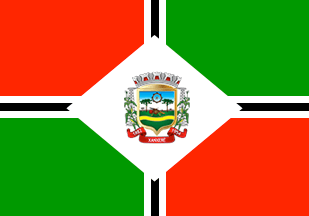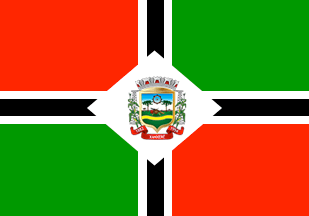 image by
Ivan Sache,
8 November 2021
image by
Ivan Sache,
8 November 2021 
Last modified: 2021-12-11 by ian macdonald
Keywords: santa catarina | xanxerê |
Links: FOTW homepage |
search |
disclaimer and copyright |
write us |
mirrors
 image by
Ivan Sache,
8 November 2021
image by
Ivan Sache,
8 November 2021
The municipality of Xanxeré (50,309 inhabitants in 2917; 37,776 ha) is
located 500 km west of Florianópolis.
Xanxerê originates in a military
colony established by Decree No. 2,502 issued on 16 November 1859. The actual
construction of the colony was delayed for decades because the Argentine
government claimed it was located on disputed territory. The Xanxerê colony was
eventually founded in 1880 and inaugurated on 14 March 1882; Captain José
Bernardino Bormann (1844-1919) was appointed its director for a period of 17
years. In 1890, it was transferred to Paraná, forming the district of
Generozópolis within the municipality of Palmas. The transfer was invalidated by
the Federal Supreme Court but Paraná refused to give back the disputed
territories. Following he arbitration by President of Brazil Wenscelau Braz, ths
issue was settled and new municipalities were established in Santa Catarina by
State Law No. 1,157 promulgated on 24 August 1917, Chapecó included. The
district of Xanxerê was established on 31 December 1917. State Law No. 1,260
promulgated on 5 November 1919 established Xanxerê as the seat of the
municipality of Chapecó.
The municipality of Xanxerê was established by State
Law No. 133 promulgated 30 January 1953 and inaugurated on 27 February 1954.
https://www.xanxere.sc.gov.br/
Municipal websute
Ivan Sache, 8 November 2021
A black upright cross, bordered white, on a field quartered in red and green, with the municipal shield in the centre on a white lozenge.
Official website at
http://www.xanxere.sc.gov.br
Dirk Schönberger,
24 August 2012
The flag and arms of Xanxerê are prescribed by Municipal Law No. 734
promulgated in 1974.
The municipal flag of Xanxerê, designed by
heraldist Arcinoé Antonio Peixote de Faria, shall be quartered per saltire, the
quarters gyronny green and red formed by four white stripes of 2 units in width
charged with black stripes of 1 unit, placed two by two in the vertical and
horizontal dimensions starting from the angles of a central white lozenge
charged with the municipal coat of arms.
In compliance with the
tradition of Portuguese heraldry, of which Brazil inherited the norms and
rules, the municipal flags have to be divided in eight, six, four or three
parts, using the same colors as in the coat of arms and featuring in the center
or at hoist a geometric figure inscribing the municipal coat of arms.
The municipal flag of Xanderé is compliant with the general rules, being
quartered by a cross that recalls people's Christian spirit. The coat of arms
featured on the flag represents the municipal government while the white
lozenge inscribing it represents the town proper, as the seat of the
municipality. White is a symbol of peace, friendship, work, prosperity, purity
and religious spirit.
The white stripes charged with black stripes
quartering the flag represent the municipal power spreading over all the
quarters of the territory. Black is a symbol of austerity, prudence, knowledge,
moderation and firmness. The quarters gyronny green and red represent the rural
estates scattered over the municipal territory. Green is a symbol of honor,
civility, courtesy, glee and abundance; it is also the symbol of hope, which is
green since greening fields in spring promise profuse harvests. Red is a symbol
of dedication, patriotic love, audacity, intrepidity, courage and valiance.
In compliance with heraldic rules, the municipal flag shall have the
official dimensions prescribed for the national flag, 14 units in width on 20
units in length.
The coat of arms of Xanxerê, designed by heraldist
Arcimoe Peixoto de Farias, is described in proper heraldic language as follows:
Samnite shield surmounted by an eight-towered mural crown argent ports gules.
On a field argent, in chief an eight-rayed bladed wheel gules. A base vert
charged with a fess wavy argent supporting two stylized Brazilian pines
surrounding two rifles sable and a drum gules. The shield supported dexter and
sinister by maize plants proper superimposed to pylons sable standing in base
of a scroll gules inscribed in letters argent with the toponym "Xanxerê"
surrounded by years "1882" and "1954'.
The coat of arms shall have the
following symbolic interpretation
1. The Samnite shield used to represent
the arms of Xanxerê was the first style of shield introduced to Portugal by
French influence; inherited by Brazilian heraldry, it evokes the colonizing
race and main builder of the nation.
2. The mural crown surmounting the
shield is the universal symbol of domains' coats of arms; argent (silver) with
eight towers, only five of them visible in perspective view, it classifies a
town of second rank or county seat. The port gules (red) recalls the predicates
of the municipality's leaders.
3. Argent (silver) is a symbol of peace,
friendship, work, prosperity, purity and religious spirit.
4. In chief, the
eight-rayed bladed wheel gules (red) is the symbol of Santa Catarina state, to
which the municipality belongs after a long dispute with Paraná.
5. The base
vert (green) represents the vast plains located on the banks of river
Chapecozinho, represented by the fess wavy argent (silver) supporting Brazilian
pines proper, characteristic of the region, the rifles sable (black) and the
drum gules (red) evokes the Xanxerê Federal Colony established in 1882, which
is the origin of the town.
6. Vert (green) is a symbol of honor, civility,
courtesy, abundance and glee; it is also the symbol of hope, which is green
since greening fields in spring promise profuse harvests.
7. Sable (black)
is a symbol of austerity, prudence, knowledge, moderation and firmness.
8.
The pylons recall electricity supplied by several waterfalls to the neighboring
municipalities. The maize plants represent the main product of the generous and
fertile soil.
9. The scroll gules (red), a color symbol of patriotic love,
dedication, audacity, intrepidity, courage and valiance, is inscribed with the
toponym "Xanxerê" surrounded by the dates of establishment of the military
colony ("1882") and political emancipation ("1954") of the municipality.
http://www.camaraxanxere.sc.gov.br/index.php/simbolos/
Municipal
Chamber website
Photos
https://www.xanxere.sc.gov.br/noticias/index/ver/codMapaItem/4504/codNoticia/609745
https://www.xanxere.sc.gov.br/noticias/index/ver/codMapaItem/4504/codNoticia/645380
https://www.facebook.com/prefeituradeXanxerê/photos/4234429396644887
https://www.facebook.com/prefeituradeXanxerê/photos/4144681698952991
Ivan Sache, 8 November 2021
 image by
Ivan Sache,
8 November 2021
image by
Ivan Sache,
8 November 2021
The flag is also used with a smaller lozenge and wider black stripes.
https://www.facebook.com/prefeituradeXanxerê/photos/4155035547917606
https://www.facebook.com/prefeituradeXanxerê/photos/3783437495077415
Ivan Sache, 8 November 2021